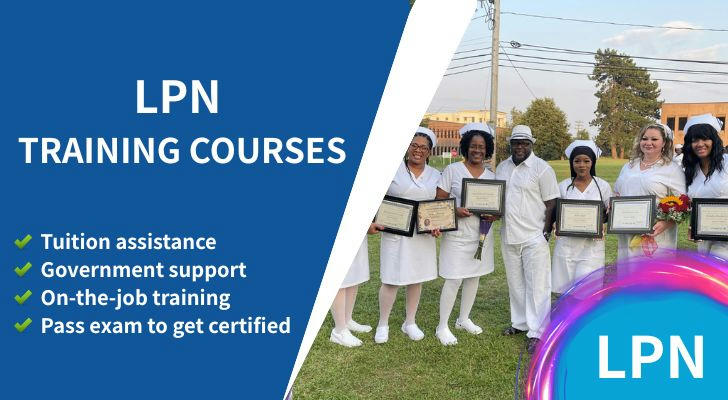Launch your nursing career with government-supported LPN courses and on-the-job training
With government-supported LPN training and flexible online LPN programs, you can earn your certification without a college degree or prior experience. These programs are designed to support you regardless of your educational background, and Many programs include on-the-job training, helping you gain real skills while you learn.

1. Why Choose Government-Supported LPN Training?
Starting your nursing career through government-supported LPN training programs offers unmatched benefits for those seeking stability, official recognition, and practical experience. These programs are often developed or endorsed by state workforce agencies and nursing boards, ensuring graduates meet official licensure requirements and are well-prepared for the NCLEX-PN licensure exam.
Why does this matter?
- Official Recognition: Programs adhere strictly to licensing standards, making your certification widely accepted by healthcare employers nationwide.
- Career Stability and Growth: The healthcare sector continues to expand, with licensed practical nurses (LPNs) experiencing steady employment demand and competitive salaries. According to the U.S. Bureau of Labor Statistics, the median annual wage for LPNs was around $50,000 in 2023, with projected employment growth of 9% through 2032—faster than the average for all occupations.
- On-the-Job Training Opportunities: Many programs integrate paid or subsidized clinical experience, providing hands-on skills that employers value while easing financial pressures.
- Clear Advancement Path: Graduates often benefit from streamlined pathways to Registered Nurse (RN) programs or other advanced healthcare roles.
Choosing a government-supported program offers a credible, efficient, and supported pathway to launch a rewarding nursing career.
How to Obtain Financial Support for LPN Training Programs
Many LPN programs provide financial assistance options to help manage tuition and related costs. These may include scholarships, grants, payment plans, and other funding resources designed to make training more affordable. State-supported initiatives often offer grants or subsidies aligned with workforce development goals to reduce the financial burden for students.
To access available aid, contact the financial aid office of your chosen program and local workforce development agencies as early as possible. Preparing key documents such as proof of residency and academic transcripts in advance can help streamline the application and approval process.
2. What You Will Learn in a Government-Supported LPN Program
These programs combine comprehensive classroom instruction with clinical practice, focusing on skills that matter most in real healthcare settings:
- Fundamentals of Nursing Care: Patient hygiene, mobility assistance, vital signs monitoring.
- Medication Administration: Safe handling, dosage calculation, and documentation.
- Anatomy and Physiology: Understanding body systems relevant to nursing care.
- Clinical Procedures: Wound care, catheter insertion, infection control protocols.
- Healthcare Communication: Interacting professionally with patients, families, and medical teams.
- Ethics and Patient Rights: Confidentiality, consent, and culturally sensitive care.
The curriculum is designed to prepare you for the NCLEX-PN licensure exam, which is mandatory to practice as an LPN. Additionally, government-supported programs often offer specialized tutoring or exam prep resources to improve your passing rate.
3. How to get government-supported LPN training programs in 2025
If you want to get government-supported LPN training in 2025, you can consider the following ways:
State Workforce Development Programs
These initiatives provide approved LPN training linked to regional employment needs, sometimes offering financial assistance or job placement services. Examples include state-sponsored healthcare apprenticeships or workforce grants. The [CareerOneStop Local Training Finder]helps find government-recognized programs nearby.Community College Programs with State Aid
Community colleges frequently partner with workforce agencies to offer accredited LPN certificates, with scholarship opportunities to ease tuition expenses.State-Backed Healthcare Grants and Education Initiatives
Some states offer LPN training as part of workforce development plans—providing tuition support, childcare, or transportation. These initiatives often target high-demand regions like Texas, Florida, and Michigan.Healthcare Employer-Sponsored LPN Training
Some healthcare providers offer structured, paid training. For example, [Loretto’s LPN Apprenticeship Program] in New York lets participants earn a paycheck while completing LPN coursework. Most education costs are covered, and the program supports career advancement within the organization.State-Approved Fast-Track or Online LPN Programs
Many schools now offer accelerated or hybrid LPN programs, allowing flexible learning. Resources like [AllNurses] help you compare fast-track options nationwide, including program length and delivery format.
How to Apply for Government-Supported LPN Training Programs
Applying for a government-supported LPN program typically involves a few straightforward steps:
Research Programs
Use resources like state workforce websites or the [CareerOneStop Local Training Finder] to find approved programs near you.Check Eligibility Requirements
Review each program’s prerequisites, which may include a high school diploma or GED, background checks, and sometimes basic health screenings.Prepare Application Materials
Gather necessary documents such as transcripts, proof of residency, identification, and any test scores or certificates required.Submit Application
Apply directly through the training provider’s website or via your state workforce development agency. Some programs may require interviews or placement tests.Seek Financial Aid
Contact the financial aid office or local workforce agency early to explore scholarships, grants, or employer assistance options.Complete Enrollment
Once accepted, follow enrollment instructions, attend orientation, and prepare for your first day of training.
5. Take the First Step Toward a Rewarding Nursing Career
Choosing a government-supported LPN training program is a strategic way to enter the healthcare field with confidence. These programs provide official recognition, practical experience, and financial support opportunities designed to help you succeed.
With the ongoing demand for practical nurses in hospitals, nursing homes, and clinics across the U.S., your training will open doors to meaningful employment and career growth. Explore approved programs near you or flexible online options, assess available financial aid, and begin your journey toward becoming a licensed practical nurse today.
